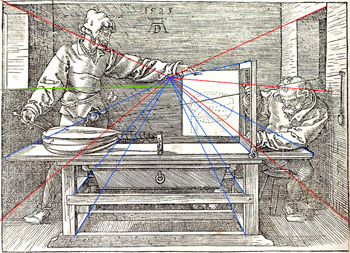Window view construction according to Duerer
As mentioned in the article on the basics of perspective drawing, Albrecht Duerer was also pioneering in the theoretical and practical development of the artistic perspective. However, he did not only write about perspective. He used his knowledge mainly in his paintings. In addition, we were also left with two woodcuts that depict very precisely how Duerer constructed difficult complex forms with the help of technical apparatus. One of these woodcuts is "The Draughtsman of the Lute" ("Der Zeichner der Laute") from 1526.
The Draughtsman of the Lute
The following graphic illustrates a somewhat complicated but plausible method of constructing a perspective image:

Albrecht Duerer: "The draughtsman of the lute" (1525), The Metropolitan Museum of Art,
woodcut of a construction arrangement for drawing perspective
You can also find and download this image at the Google-Art-Projekt (The Metropolitan Museum of Art).
A lute is a very complicated body. It is accordingly difficult to bring it correctly onto a sheet of paper by rejuvenating the neck of the lute. Duerer has used a very clever construction method in woodcuts: A (window) frame is attached to a table (right in the picture). The lute lies on the table. In the frame there is a hinge for a picture carrier, which can be folded into the window, but also opened. A hook is attached to the wall behind the table (right), through which a string with a weight runs. A stick is attached to the other end of the string for easier handling.
The hook as observer

The hook as observer
How can you create a perspective drawing with it, like the sheet in the woodcut shows? Quite simple: The hook in the wall corresponds to the viewer of the future picture. The rays of vision emanate from it. The artist now holds the end of the string to a certain point. A helper now marks exactly the point where the string passes through the fanster. He probably does this with two thin wooden rods, which he holds from two sides in such a way that they cross each other exactly on the string (of course without disturbing the straight course of the string).
The artist now loosens the end of the string, folds the picture carrier in the frame and draws a dot on the picture carrier exactly at the point that the assistant has fixed with the crossed sticks. This point corresponds exactly to the one he had previously marked on the lute. Gradually, all relevant points of the object are marked on the image carrier. In the end, the artist only has to connect the dots on the picture carrier and thus obtains an exact perspective representation of this instrument, which is very difficult to draw.
Analysis of the perspective in Duerer's woodcut

Perspective (vanishing point and vanishing lines)
in Duerer's woodcut "The Draughtsman of the Lute"
Of course, Duerer also created his woodcut in perspective. The vanishing point is on the wall below the outstretched arm. Strangely enough only almost all escape lines run towards this vanishing point. The window ledge on the left deviates from it. With the window ledge on the right it is not to be determined clearly. Why Duerer made this mistake is unclear. It is conceivable that he started the preliminary drawing with the window ledge and planned to place the horizon line exactly on this window ledge line. Then he noticed that the taper of the upper surface of the lute was too small. The instrument might not have been identifiable at first glance. He therefore shifted the vanishing point (and thus the horizon line) slightly upwards. Thus the lute is well recognizable. It is unclear why he did not correct this mistake in the following woodcut. Maybe he simply forgot.
From today's "modern" point of view one could also interpret that Duerer deliberately made this mistake. Because a picture is a picture. A picture does not show real spatial depth, but it simulates spatial depth with the help of perspective. As an artist one does not construct exact copies of the world, but creates one's own pictorial worlds. The error in the windowsill could be proof of Duerer's self-confident understanding of the artist. Looking back, however, this is unlikely.
What Duerer might have meant, or whether it is actually a mistake, is left to the viewer. Strangely enough, there is no reference to this in the extensive Duerer literature.
Two perspectives in one picture

Two perspectives in one: viewer and construction
of the beholder - "I see myself seeing myself" (Valery)
What is special about this picture is that there are two perspectives: on the one hand, there is the hook on the wall, which represents the future viewer of the picture. This hook "looks" at the top of the lute. And then, of course, there is the viewer of the woodcut. He observes himself quasi while observing. Or to say it with Paul Valery: "I see myself seeing myself".
The figure on the right illustrates this. The woodcut shows a virtual viewer (A1) aiming at a point on the lute (A3). This point is fixed in the "window view" (A2).
The viewer of the woodcut, "I" (B1) now sees this point on the drawing (B2). The point B2 corresponds to the point A3 - but this is the special feature of a perspective drawing: reality and image merge. The illusion of reality.
More about the perspective as a method of artificial construction
- Perspective [1]: perspective drawing with vanishing point and vanishing lines
- Kunsthistorische Entwicklung der Perspektive
- The MET: The Draughtsman of the Lute
More about Albrecht Duerer
More Tutorials
- ...